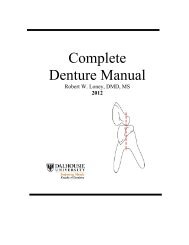RPD Manual 11 - Removable Prosthodontics - Dalhousie University
RPD Manual 11 - Removable Prosthodontics - Dalhousie University
RPD Manual 11 - Removable Prosthodontics - Dalhousie University
You also want an ePaper? Increase the reach of your titles
YUMPU automatically turns print PDFs into web optimized ePapers that Google loves.
Framework Adjustment - 87<br />
be bent. Heat generation is one of the reasons major adjustments are made prior<br />
to acrylic placement (i.e. the heat would melt the acrylic).<br />
5. Completely remove any media contaminated with metal grindings and place fresh<br />
media. Repeat this procedure until full seating is achieved. At this point a thin,<br />
even film of media should be observed under rests and indirect retainers. The<br />
wax or silicon media will have a greyish hue from the underlying metal. The feel<br />
of the denture upon seating will change from a grating or snapping sensation to<br />
one of a gliding sensation. Normal adjustment of a framework should take no<br />
longer than 20 minutes.<br />
6. Check for soft tissue impingements using pressure-indicating paste. Remove a<br />
small portion from the jar, and place it on a mixing pad. Use a stiff-bristled brush<br />
to spread a thin layer over the tissue surfaces of the major connector, and<br />
infrabulge clasps. Leave streaks in the paste. Place intraorally with moderate<br />
pressure and remove. Relieve any areas of marked burn-through. If streaks are<br />
left in the paste, this indicates no contact with the tissues. Adjust or leave<br />
accordingly. Maxillary palatal connectors should exhibit broad even contact with<br />
the palate.<br />
7. If the framework cannot be adequately adjusted, it should be remade. In some<br />
cases this decision may be made at the pre-clinical inspection stage. Make this<br />
determination early, so that time will allow for a new impression to be made.<br />
Determine if the casting fits similarly on the cast and in the mouth. If it does not,<br />
the final impression was most likely inaccurate and should be remade. If the<br />
casting does fit similarly, the discrepancy may be due to laboratory errors. In<br />
many cases abrasion of the master cast will require re-making of the final<br />
impression as well. If the pre-clinical inspection leads the dentist to believe a<br />
remake is a possibility, a new custom tray should be made prior to the patient<br />
appointment in anticipation of the need for a new impression.<br />
Occlusal Adjustments to the Framework<br />
Since most frameworks are be fabricated on unmounted casts there are usually occlusal<br />
interferences present on rests and indirect retainers. These should be adjusted at this time.<br />
Vertical dimension should remain unchanged by a removable partial denture in almost all<br />
instances. The framework should not interfere with normal centric and eccentric contacts<br />
of the maxillary and mandibular teeth. Contacts should be identical with and without the<br />
framework in the mouth.<br />
Mark occlusal contacts with thin articulating paper and remove the framework for<br />
adjustment. The highly polished metal surfaces do not mark well with articulating paper<br />
so that the opposing occlusion should be checked for heavy contacts. Diamond burs,<br />
heatless stones, Shofu coral stones or cross cut Brasseler lab burs will most readily remove<br />
interferences. DO NOT FORGET TO LOCATE AND ADJUST EXCURSIVE<br />
INTERFERENCES.<br />
When maxillary and mandibular frameworks are being adjusted, they should be adjusted<br />
individually, then placed in the mouth together to eliminate interferences between the<br />
frameworks. Occlusal rests or indirect retainers that have inadequate thickness (< 1.5 mm)















